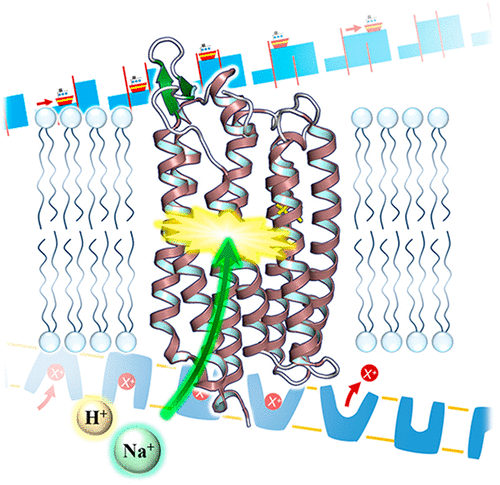当前位置:
X-MOL 学术
›
Chem. Rev.
›
论文详情
Our official English website, www.x-mol.net, welcomes your
feedback! (Note: you will need to create a separate account there.)
Light-Driven Sodium-Pumping Rhodopsin: A New Concept of Active Transport
Chemical Reviews ( IF 51.4 ) Pub Date : 2018-03-07 00:00:00 , DOI: 10.1021/acs.chemrev.7b00548 Hideki Kandori , Keiichi Inoue 1 , Satoshi P. Tsunoda 1
Chemical Reviews ( IF 51.4 ) Pub Date : 2018-03-07 00:00:00 , DOI: 10.1021/acs.chemrev.7b00548 Hideki Kandori , Keiichi Inoue 1 , Satoshi P. Tsunoda 1
Affiliation

|
Ion pumps perform active transport of ions by using energy. The active transport mechanism can be illustrated by the Panama Canal model, which considers two gates and a gain in energy. The Panama Canal model is consistent with the alternating access model that is used to describe active transport, in which the substrate ion is bound, energized, and released. It was generally accepted that energization occurs only for an ion-bound protein but not for an ion-unbound protein. Light-driven proton and chloride pumps, two of the best studied pumps, are represented by the Panama Canal model. In this case, light absorption takes place for the bound state of ions (proton and chloride ions) in the active center (protonated Schiff base of the retinal chromophore). In contrast, a recently discovered light-driven sodium pump, Krokinobacter eikastus rhodopsin 2 (KR2), is a unique active transporter that does not bind the transport substrate, the sodium ion, in its resting state. The molecular architecture and photoreaction cycle of the light-driven sodium pump are very similar to those of proton and chloride pumps, although sodium ions are actively transported without initial binding. Sodium uptake is a diffusive process, but the presence of two gates allows the unidirectional transport of sodium ions. In this sense, the light-driven sodium pump is also represented by a modified Panama Canal model. Current understanding of the light-driven sodium pump is reviewed.
中文翻译:

光驱动钠泵视紫红质:主动运输的新概念。
离子泵利用能量执行离子的主动传输。主动运输机制可以用巴拿马运河模型来说明,该模型考虑了两个闸门和一个能量增益。巴拿马运河模型与用于描述主动运输的交替访问模型一致,在该模型中,底物离子被束缚,激励和释放。人们普遍认为,通电仅发生在离子结合的蛋白质上,而没有发生在离子未结合的蛋白质上。巴拿马运河模型代表了光子驱动的质子泵和氯化物泵,这是研究最多的两个泵。在这种情况下,在活性中心(视网膜生色团的质子化席夫碱)中,离子(质子和氯离子)的结合状态发生光吸收。相比之下,最近发现的光驱动钠泵致病性杆状假单胞菌视紫红质2(KR2)是一种独特的活性转运蛋白,在其静止状态下不结合转运底物钠离子。光驱动钠泵的分子结构和光反应周期与质子泵和氯离子泵非常相似,尽管钠离子是在没有初始结合的情况下被主动转运的。钠的吸收是一个扩散过程,但是两个闸门的存在允许钠离子的单向传输。从这个意义上讲,光驱钠泵也以改进的巴拿马运河模型为代表。综述了目前对光驱动钠泵的了解。
更新日期:2018-03-07
中文翻译:

光驱动钠泵视紫红质:主动运输的新概念。
离子泵利用能量执行离子的主动传输。主动运输机制可以用巴拿马运河模型来说明,该模型考虑了两个闸门和一个能量增益。巴拿马运河模型与用于描述主动运输的交替访问模型一致,在该模型中,底物离子被束缚,激励和释放。人们普遍认为,通电仅发生在离子结合的蛋白质上,而没有发生在离子未结合的蛋白质上。巴拿马运河模型代表了光子驱动的质子泵和氯化物泵,这是研究最多的两个泵。在这种情况下,在活性中心(视网膜生色团的质子化席夫碱)中,离子(质子和氯离子)的结合状态发生光吸收。相比之下,最近发现的光驱动钠泵致病性杆状假单胞菌视紫红质2(KR2)是一种独特的活性转运蛋白,在其静止状态下不结合转运底物钠离子。光驱动钠泵的分子结构和光反应周期与质子泵和氯离子泵非常相似,尽管钠离子是在没有初始结合的情况下被主动转运的。钠的吸收是一个扩散过程,但是两个闸门的存在允许钠离子的单向传输。从这个意义上讲,光驱钠泵也以改进的巴拿马运河模型为代表。综述了目前对光驱动钠泵的了解。











































 京公网安备 11010802027423号
京公网安备 11010802027423号